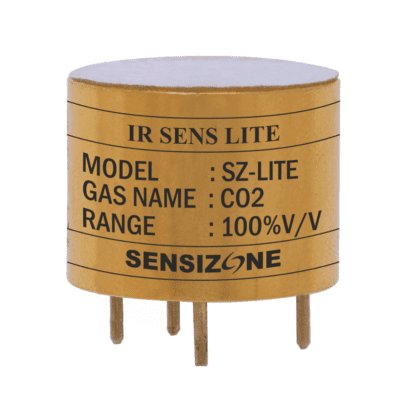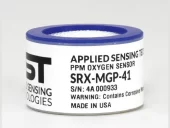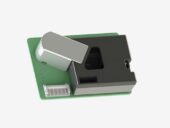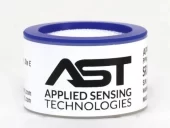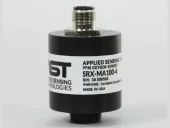Description
Principle of NDIR Gas Sensor
“The basic measurement principle is called non dispersive infrared (NDIR) gas detection, which is based on the absorption of infrared radiation at certain gas specific wavelengths in accordance with the Beer-Lambert law. The most common gases that are measured with this NDIR principle are Carbon Dioxide (CO2), Methane (CH4) and Hydrocarbons (HC). Also gases like Carbon Monoxide (CO), Nitrous Oxide (N2O) and Sulphur Hexafluoride (SF6) are possible to detect.”
Working principle of Non-Dispersive Infrared (NDIR)
“A Non Dispersive Infrared (NDIR) gas sensor working principle is based on the property of certain molecules to absorb light at specific wavelengths (or “color”) that are characteristic of their molecular structure. The absorption characteristics are defined as molecular vibrational energies associated with stretching, bending or rotations and depends upon the molecular structure of the gas. For IR energy to be absorbed, that is for vibrational energy to be transferred to the molecules, the frequency must match the frequency of the mode of vibration. Thus, specific molecules absorb IR radiation at precise frequencies and each gas has a unique and well defined light absorption curve in the infrared spectrum.
When IR radiation passes through a volume containing a specific gas, only those frequencies matching the vibration mode are absorbed, while the rest of the light is transmitted without interference. For this reason, the presence of a particular gas gives rise to characteristic absorption bands.”
Features Applications
- Infrared Gas Diffusion Sensor • Oil & Gas
- Pre Calibrated • Energy
- Compact Design • Medical
- 3.3 VCC Supply Voltage • Smart City Application
- Sensor Life > 5 Year • Industrial
- Low drift • HVAC • High Voltage Switch-gear
| LIST OF NDIR BASED GAS WITH ENVIRONMENTAL CONDITION | ||||||
| Sr. No. | MODEL NO. | GAS NAME | GAS FORMULA | GAS RANGE | RESOLUTION | ACCURACY |
| 1 | SZ-LITE-N2O-1000 | Nitrous oxide | N2O | 1000 PPM or more | 1 PPM | < 5 % of Reading or ±20 PPM Whichever is More |
| 2 | SZ-LITE-CO-10% | Carbon monoxide | CO | 10%V/V | 0.01%V/V | < 3% of Reading or ±0.2% V/V Whichever is More |
| 3 | SZ-LITE-CO2-5000 | Carbon dioxide | CO2 | 5000 PPM | 1 PPM | < 5% of Reading or ±50 PPM Whichever is More |
| 4 | SZ-LITE-CO2-10000 | Carbon dioxide | CO2 | 10000 PPM | 1 PPM | < 5% of Reading or ±30 PPM Whichever is More |
| 5 | SZ-LITE-CO2-5% | Carbon dioxide | CO2 | 5% V/V | 0.01% V/V | < 5% of Reading or ±0.5% V/V Whichever is More |
| 6 | SZ-LITE-CO2-100% | Carbon dioxide | CO2 | 100% V/V | 0.1% V/V | < 2 % of Reading or ±0.5% V/V Whichever is More |
| 7 | SZ-LITE-CH4-100% | Methane | CH4 | 100 % LEL | 0.1% LEL | < 5 % of Reading or ±0.5% LEL Whichever is More |
| 8 | SZ-LITE-CH4-100% | Methane | CH4 | 100% V/V | 0.1% V/V | < 5% of Reading or ±0.5% V/V Whichever is More |
| 9 | SZ-LITE-HC-100% | Hydrocarbon | HC | 100 % LEL | 0.1% LEL | < 5% of Reading or ±0.5% LEL Whichever is More |
| 10 | SZ-LITE-R134a-1000 | Refrigerant | R134a | 1000 PPM or more | 1 PPM | < 5% of Reading or ±30 PPM Whichever is More |
| 11 | SZ-LITE-SF6-1000 | Sulphur hexafluoride | SF6 | 1000 PPM or more | 1 PPM | < 5% of Reading or ±30 PPM Whichever is More |

